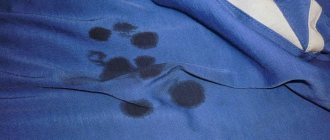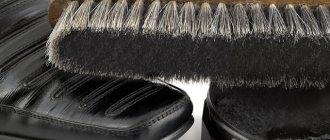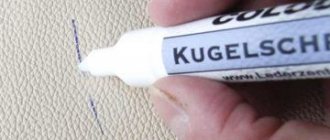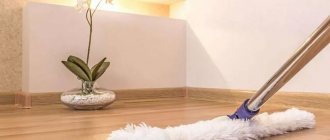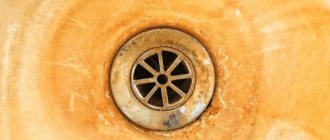Marble has been used by mankind as a decorative material since ancient times. Unique data on its processing have survived to this day, but not everyone knows that it needs careful care. Cleaning marble is a painstaking process that must be carried out according to certain specifications. Neglecting them will certainly lead to loss of attractiveness and damage to the integrity of the product.
In most European countries, people who use marble in interior design take care of it and pay special attention to its protection. In our area, people think less about caring for their floors, as a result of which the stone darkens and loses its original appearance.
How not to clean marble!
Remember, no matter how much craftsmen advise you, you cannot clean marble with vinegar, wine, orange juice, Coca-Cola, any abrasive detergents (chalk chips, sand, etc.), or any products containing acid (including for washing baths), ceramic tile cleaning products. Even weak acids will destroy the structure of the stone , and powders and abrasive chips will leave scratches. Many companies offer marble cleaning; they come to you and clean it with abrasives so that later your marble will be unrecognizable. Run away from them as fast as you can. It is possible to restore marble after such cleaning, but you will spend much more money than buying a special mild detergent for washing marble.
What should not be used to clean marble surfaces.
- ordinary household cleaning products (all kinds of detergents, cleaning and washing powders such as “Domestos”, “Fairy” and others), because the most non-aggressive acids can destroy the natural stone structure, and powders will certainly leave scratches on the surface. You should also not use a ceramic tile cleaner.
- acidic substances (for example, juice or vinegar), as they can damage the polishing coating of the stone.
Therefore, before contacting a cleaning company, be sure to find out what means and methods they use to clean marble surfaces in order to avoid the negative consequences of cleaning.
How to prevent marble from deteriorating and preventing stains from forming
If you have marble floors near your front door, place a rug in front of it. Grains of sand and particles of dirt stuck to the shoes will constantly scratch the floor, and the marble will very quickly become dull and worn out.
If you have marble floors in your home, don't walk on them with shoes . Whether you like to walk barefoot or not, this is the most reliable way to keep marble intact. The fact is that dust and dirt will certainly stick to your shoes, especially with hard soles, and even more so with heels, grains of sand will get into the sole, all this will systematically destroy and scratch the marble surface, violating its original appearance.
If you have marble countertops in your kitchen, try using cutting boards for cutting food. Place glass glasses only on coasters, especially wine glasses (wine is acidic). Place hot dishes only on stands; do not remove them from the heat and place them on a stone countertop; a sharp temperature change may cause the stone to crack, or begin to disintegrate and crumble.
If you have a marble sink, bathtub, or shower, wipe the surface with a rubber squeegee after each water treatment to prevent dull soapy marks from depositing on the stone.
Try to wipe down your marble daily. The longer dirt remains on it, the sooner it will eat into the stone. Avoid using soaps and detergents made from refined petroleum products . They will make the stone dull and faded. You can coat marble with wax , this will help preserve it. Use only clear wax and never apply it to white marble - the marble may turn yellow. Many stains can be removed with a solution of ammonia, but try not to use it too often, as this will also harm the stone.
How to clean a marble floor
The principle is simple; cleaning marble consists of two stages:
- cleaning;
- marble protection.
Before washing, you need to dry clean the stone and remove dirt, dust and other small solid contaminants from the surface using a coarse brush. Next, the floor must be treated with a special protective composition for daily use (for example, LEM-3 cleaner).
To remove strong and stubborn stains, it is important to use concentrated, safe cleaning solutions (Ultra Stripper). After wet cleaning, the stone must be completely dry naturally, and after that you can begin to apply a protective coating to the surface.
There are three methods that help keep your flooring looking great for a long time:
- Application of wax. It helps create a protective film on the surface of the marble that lasts for a long time, protecting it. The wax-coated stone shines and retains its original appearance for a long time.
- Since this is a porous material, it absorbs various compounds well, so it is best to impregnate the surface with special dirt-repellent agents . They prevent various contaminants from penetrating deep into the structure of the stone, creating a special protective film, making it easier to clean. Such impregnations additionally tint the stone; after their application, it looks wet and shiny.
- The third method is mixed, it includes a combination of impregnation and wax . The owner does not need to apply the compositions one by one; ready-made products are available for sale. Idea HP has proven itself best.
In stores you can also find combined detergents that are suitable for daily use. They contain synthetic and natural wax, as well as safe cleaning ingredients.
Most owners of marble floors prefer to apply polish to the surface after washing. Such compounds have a special anti-slip effect.
Daily marble care
All you need is water, a soft cloth and a piece of chamois. Wipe the marble with a cloth soaked in warm water and polish it until shiny with suede (or another dry cloth or towel). Once or twice a year, wash the marble with a warm detergent - a solution of mild dishwashing detergent will do. After this, rinse the marble again with warm water and polish it dry.
If you spill or drop something on the marble, try to clean it up immediately with a sponge or rag soaked in warm water. Do not leave the stain on overnight. If you've just spilled wine, wipe it up as quickly as possible with a paper towel, being careful not to rub, otherwise the stain may set in. Rinse several times with warm water and wipe with a dry cloth.
Mold
Biological stains such as mold and mildew can be removed from your marble surfaces using a combination of home remedies: hydrogen peroxide, water and dishwashing liquid. Use a spray bottle to apply the solution and then scrub the area until the stain disappears. Always wipe the area with water to remove any residue.
Juicy roll made from simple ingredients: potatoes, cheese and ham
Blue or yellow: how to calculate your interior color by date of birth
With a wrap, a slit, and buttons: how to create looks with basic skirts in spring
Removing stains from marble
The most important thing in removing stains from marble is to understand the reason for their formation. Be a detective, understand what most often happens in the place where you found the stain, and what its origin may be.
Make a cleaning mass from some white (colored ones will leave marks) absorbent material (blotter, napkin, paper towel). Soak it thoroughly in the cleaning solution described below (depending on the type of stain). Spread the cleaning paste (do not use acids!) over the entire surface of the marble in a layer 6-7 mm thick. Leave it on the surface for a period of 1 to 48 hours, depending on the age and brightness of the stain. Cover the top with a damp cloth and plastic or film to prevent the mixture from drying out. Attach the film to the surface. (Theoretically, you don’t have to cover the stone with film, then you will have to wet the paste as it dries).
Removing stains of organic origin from marble (tobacco, tea, coffee, other drinks (excluding juices and wine), leaves, bark, urine and animal droppings).
Such spots leave pinkish marks. On the street they can gradually pass on their own, washed out by the rain and brightened by the sun. Indoors, they are best removed by bleaching. A mixture of a 20 percent solution of hydrogen peroxide and a few drops of ammonia is suitable. Soak your white mixture in this solution and let it sit for 24 hours. When finished, rinse the marble thoroughly with warm water and wipe dry.
Removing greasy oil stains from marble (oil, grease, cream, lotions, cosmetics, resin, etc.)
Such stains leave dark marks on the stone. As soon as possible, apply some kind of absorbent powder - chalk chips or even starch - to the stain. After some time (as it absorbs), remove the dirty powder and apply a new one. Leave for 24 hours. Remove the powder with a stiff brush dipped in a hot solution of household detergent. Wipe dry and polish. (Alternatively, you can wipe the powder with a rag soaked in ammonia). If, nevertheless, this alkaline option turns out to be not strong enough, you will have to use a solvent. Moisten the white mass (as described above) with acetone or amyl acetate (sold in pharmacies), open the windows, ensure good ventilation, and never use near fire or sparks. Try not to leave it for long.
Removing rust from the surface of marble.
Rust (brown stains from iron, greenish from bronze and copper) usually forms where marble comes into contact with metal lamps, bolts, nails, iron flower pots, etc. Use a commercial marble rust remover . Follow the instructions carefully and do not leave it on for long as it is a chemical and may break down the stone. Stubborn metal stains are incredibly difficult to remove and can remain on the stone forever.
Removing plant stains in showers and swimming pools (algae, fungi, mold, moss, lichen)
Wipe with a solution of ammonia or hydrogen peroxide. Do not even think about mixing them together; a chemical reaction will occur, resulting in the formation of a deadly poisonous gas!
Removing ink stains from marble (pens, ink, etc.)
Such stains can be removed with hydrogen peroxide, nail polish remover or acetone. Be careful, peroxide is suitable for light-colored stones; light stains may remain on dark ones! Acetone, on the contrary, is suitable for dark stone.
Rain stains and stubborn hard water deposits on marble.
They are removed with a dry, thin metal web (the kind used for cleaning pots, just choose the most delicate and thin one). Be careful - this is an abrasive that can remove the top layer of your surface, and then you will have to polish the surface
Juice and soda stains.
Such strong irritants destroy marble (break the shine), so if you spill liquid on marble, clean it up and wipe it off with a dry cloth immediately. Rinse the surface and wipe dry. If it is already damaged and the shine has disappeared, you will have to start polishing.
Safe stain removers
Marble cleaning is carried out only with specialized preparations that are gentle on natural stone and cannot damage its surface. Bellinzoni brand products are rightfully considered leaders in this niche.
The following products have proven themselves to be the best:
- Stone Care Kit. This is a whole care kit not only for floors, but also for all marble products. It includes a cleaning agent, a protective coating, and a polish.
- Spray RR/1. As the name suggests, this is a foamy spray cleaner that, thanks to its texture, penetrates deeply into the thickness of the stone and effectively pushes contaminants out. The product is safe for stone, easy to use and can be used for daily care of marble floors.
- Mangia Macchia paste copes well with organic dirt, grease stains and coloring liquids. The composition does not contain coarse abrasive particles, it is not capable of disturbing the integrity of the stone polishing, and no streaks appear on the surface. Can be used for both light stains and deep cleaning.
- Detergent LEM-3. A deep cleaning product that helps remove old and severe dirt from the surface. It comes in the form of a concentrate, so it must be diluted with plenty of water. But if the dirt is very ingrained, then the marble cleaner can be applied in its pure form.
- Rusteater. The simplest concentrated product, which comes in gel form. Suitable for removing rust from the surface of natural stone. You can fully care for marble with its help only in the case of countertops in the bathroom or kitchen.
Cleaning dull marble.
Cleaning dull marble and giving it its former shine is a rather complex process that depends on where the marble surface is located, the type of marble, and what caused it to lose its shine. You can use special marble cleaning products that are sold in specialized stores to add shine, but this is sometimes not enough due to the depth of damage to the marble surface. Then you will need the help of specialists who will polish the marble surface. You should be careful about polishing liquids for marble, because... overuse may damage the surface.
Dye
If you can do it carefully, the best way to remove the paint is to scrape it off with a razor blade. Large stains or streaks can be removed with solvent or paint remover, although this may damage the top of the surface and require sanding after removing the stain. Make sure you follow the directions on the cleaner or solvent and take proper safety precautions when doing so.
Properties of cast marble
The production technology allows us to obtain a material that is superior to natural marble in many respects and has special properties:
- high strength - in artificial marble there are no voids or internal cavities, which are filled with resin during the pouring process, and this allows the strength of acrylic products to be several times higher;
- long-term preservation of appearance - the coloring pigments used in production do not lose their properties under the influence of ultraviolet radiation;
- environmental safety - after hardening, marble surfaces become chemically neutral to the effects of aggressive substances (unlike natural marble, which is dissolved by acids);
- practicality - artificial marble is easy to clean from any contaminants, the products are pleasant to the touch, bathtubs made of cast marble retain heat for a long time.
Ensuring the preservation of the properties of products made from cast marble depends on strict adherence to the rules of care for the products.
Important!
Natural marble almost always has its own background radiation. A long stay in a room with “radiation” negatively affects health and causes diseases, and this is another argument in favor of an artificial analogue.
The following are made from cast marble:
- sinks;
- baths;
- window sills;
- countertops for tables and bar counters.
All these products become dirty during their intended use and require care in the form of cleaning and washing.
How to clean a dirty and blackened monument
If the monument is heavily soiled, the product is first cleaned with a dry brush to remove large build-ups of dirt. You can clean a monument made of marble chips using a soap solution and laundry soap. Stubborn stains are removed with a special powder or paste. Powder products are pre-diluted in water. Never apply the powder directly to the marble, otherwise it will scratch the material. After treatment, rinse the obelisk with warm, clean water and a sponge or cloth.
You can clean marble from stains, greens and bark, blackness and other contaminants using baking soda. The monument is also first cleaned of build-up of dirt and dust. Soda is diluted in water and applied to the surface of the product. Then you should polish the marble with a soft cloth. This method will not only clean, but also renew the marble monument, returning freshness and presentable appearance.
Another problem that a marble monument may encounter is mold. The product is in constant contact with moisture and dampness. In addition, there are usually trees nearby, from which numerous fungi spread to the marble. To remove mold or mildew, you first need to clean the sculptures in the usual way and dry them. Then a special bioprotective composition is applied to the surface, which will destroy the fungi.
Restoration. Help from a stone specialist
If the surface of the product is already damaged, be it a scratch, chip or stain, you can resort to the restoration process. Defects in polishing can be corrected by re-polishing the product. On our website you can order a call to the home of a master restorer. He will examine the defects of the product and advise you on the possibilities of eliminating them. And if necessary, he will dismantle the product and carry out the necessary work.
Take care of your marble product, and it promises to become a family heirloom, passed down in your family from generation to generation.
Removing organic stains
Often liquids such as coffee, wine or juice may spill on the marble surface. Traces of grass or animal waste products may also appear. Such stains leave light pink stains on the marble.
The advantage of this natural stone is that under the influence of the sun and rain, such marks can disappear on their own, without human intervention. But this only applies to those surfaces that are located outdoors. But if this happened indoors, you will have to use bleach. To do this, you need to mix hydrogen peroxide, preferably 20%, with ammonia. Then you will need a white mass of napkins or paper towels. It needs to be soaked in the resulting solution and applied to the stain. After 24 hours, everything is washed off with water and wiped dry.
Stains on the stone
An important point that requires special attention. Marble is a porous material. Coloring liquids (wine, coffee, tea and juices) can be absorbed into the pores of marble by several millimeters. This makes the cleaning process extremely difficult, and often makes it impossible.
If a highly pigmented liquid is spilled on a stone, the contamination should be promptly removed and treated with a soap solution.
With granite the situation is simpler, because... granite absorbs liquids very poorly. However, if you spill a strongly colored liquid (red wine, blueberry jam, etc.) and leave it for a long time, stains will remain even on granite.
If the stain cannot be removed this way, the stained area should be treated with a special stain remover for natural stone. Pay special attention to the selection of such a product. An important point in removing stains is that you must act strictly in accordance with the instructions. Even if you choose a quality product, it is difficult to give guarantees, since the success of the stain removal process directly depends on the nature of the contamination and the porosity of the marble itself.
As mentioned above, it is possible to avoid these problems by performing preventive maintenance of the stone.


